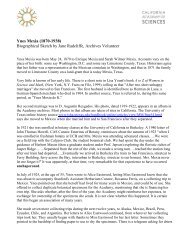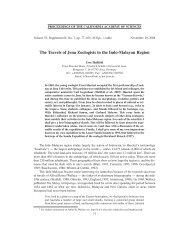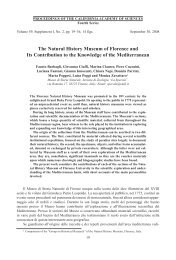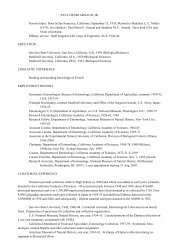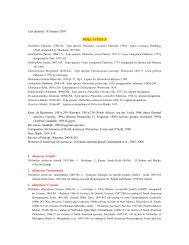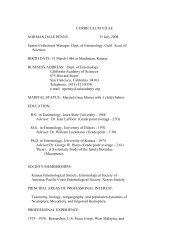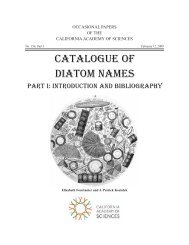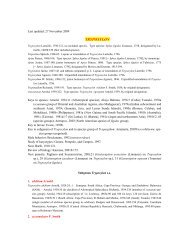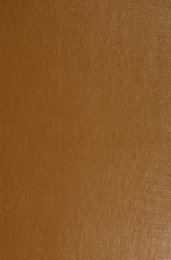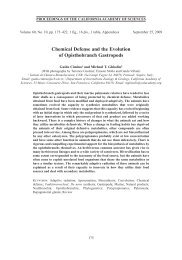- Page 1: Bibliography of Sphecidae 1 Parapsa
- Page 5 and 6: Bibliography of Sphecidae 5 ander,
- Page 7 and 8: Bibliography of Sphecidae 7 ety of
- Page 9 and 10: ACHTERBERG, C. VAN , see: VAN ACHTE
- Page 11 and 12: Bibliography of Sphecidae 11 AL-ALI
- Page 13 and 14: Bibliography of Sphecidae 13 Obitua
- Page 15 and 16: Bibliography of Sphecidae 15 2006a.
- Page 17 and 18: Bibliography of Sphecidae 17 * 1985
- Page 19 and 20: Bibliography of Sphecidae 19 * 1995
- Page 21 and 22: Bibliography of Sphecidae 21 * 2004
- Page 23 and 24: Bibliography of Sphecidae 23 * 1993
- Page 25 and 26: Bibliography of Sphecidae 25 The En
- Page 27 and 28: Bibliography of Sphecidae 27 * 1942
- Page 29 and 30: Bibliography of Sphecidae 29 List o
- Page 31 and 32: Bibliography of Sphecidae 31 32, Pr
- Page 33 and 34: Bibliography of Sphecidae 33 BAJÁR
- Page 35 and 36: Bibliography of Sphecidae 35 BALLES
- Page 37 and 38: Bibliography of Sphecidae 37 * 1923
- Page 39 and 40: Bibliography of Sphecidae 39 * 1952
- Page 41 and 42: Bibliography of Sphecidae 41 * 1969
- Page 43 and 44: Bibliography of Sphecidae 43 1947f.
- Page 45 and 46: Bibliography of Sphecidae 45 * 1945
- Page 47 and 48: Bibliography of Sphecidae 47 BIANCH
- Page 49 and 50: Bibliography of Sphecidae 49 * 1915
- Page 51 and 52: Bibliography of Sphecidae 51 BLACKM
- Page 53 and 54:
Bibliography of Sphecidae 53 * 1952
- Page 55 and 56:
Bibliography of Sphecidae 55 * 1970
- Page 57 and 58:
Bibliography of Sphecidae 57 BOHART
- Page 59 and 60:
Bibliography of Sphecidae 59 BONELL
- Page 61 and 62:
Bibliography of Sphecidae 61 BOUČE
- Page 63 and 64:
Bibliography of Sphecidae 63 BRADLE
- Page 65 and 66:
Bibliography of Sphecidae 65 BRIDWE
- Page 67 and 68:
Bibliography of Sphecidae 67 * 1985
- Page 69 and 70:
Bibliography of Sphecidae 69 * 2007
- Page 71 and 72:
Bibliography of Sphecidae 71 BURNHA
- Page 73 and 74:
Bibliography of Sphecidae 73 CALLAN
- Page 75 and 76:
Bibliography of Sphecidae 75 * 1890
- Page 77 and 78:
Bibliography of Sphecidae 77 * 1904
- Page 79 and 80:
Bibliography of Sphecidae 79 * 1912
- Page 81 and 82:
Bibliography of Sphecidae 81 Résul
- Page 83 and 84:
Bibliography of Sphecidae 83 CASOLA
- Page 85 and 86:
Bibliography of Sphecidae 85 * 1955
- Page 87 and 88:
Bibliography of Sphecidae 87 CHEVIN
- Page 89 and 90:
Bibliography of Sphecidae 89 CLARK,
- Page 91 and 92:
Bibliography of Sphecidae 91 * 1940
- Page 93 and 94:
Bibliography of Sphecidae 93 COOPER
- Page 95 and 96:
Bibliography of Sphecidae 95 * 1869
- Page 97 and 98:
Bibliography of Sphecidae 97 * 1986
- Page 99 and 100:
Bibliography of Sphecidae 99 * 1880
- Page 101 and 102:
Bibliography of Sphecidae 101 CRUZ-
- Page 103 and 104:
Bibliography of Sphecidae 103 Linn.
- Page 105 and 106:
Bibliography of Sphecidae 105 DAVIS
- Page 107 and 108:
Bibliography of Sphecidae 107 * 195
- Page 109 and 110:
Bibliography of Sphecidae 109 * 195
- Page 111 and 112:
Bibliography of Sphecidae 111 Obitu
- Page 113 and 114:
Bibliography of Sphecidae 113 DELFI
- Page 115 and 116:
Bibliography of Sphecidae 115 DESPA
- Page 117 and 118:
DITTRICH, R. Bibliography of Spheci
- Page 119 and 120:
Bibliography of Sphecidae 119 DONAT
- Page 121 and 122:
Bibliography of Sphecidae 121 DRAPI
- Page 123 and 124:
Bibliography of Sphecidae 123 * 190
- Page 125 and 126:
Bibliography of Sphecidae 125 DUNBA
- Page 127 and 128:
Bibliography of Sphecidae 127 Wisse
- Page 129 and 130:
Bibliography of Sphecidae 129 * 197
- Page 131 and 132:
Bibliography of Sphecidae 131 * 192
- Page 133 and 134:
Bibliography of Sphecidae 133 * 195
- Page 135 and 136:
Bibliography of Sphecidae 135 * 197
- Page 137 and 138:
Bibliography of Sphecidae 137 EVANS
- Page 139 and 140:
Bibliography of Sphecidae 139 * 187
- Page 141 and 142:
Bibliography of Sphecidae 141 FALCO
- Page 143 and 144:
Bibliography of Sphecidae 143 FELTO
- Page 145 and 146:
Bibliography of Sphecidae 145 * 200
- Page 147 and 148:
Bibliography of Sphecidae 147 * 198
- Page 149 and 150:
Bibliography of Sphecidae 149 * 199
- Page 151 and 152:
Bibliography of Sphecidae 151 * 189
- Page 153 and 154:
Bibliography of Sphecidae 153 * 199
- Page 155 and 156:
Bibliography of Sphecidae 155 FRITZ
- Page 157 and 158:
Bibliography of Sphecidae 157 FULLA
- Page 159 and 160:
Bibliography of Sphecidae 159 GARLA
- Page 161 and 162:
Bibliography of Sphecidae 161 * 198
- Page 163 and 164:
Bibliography of Sphecidae 163 GAYUB
- Page 165 and 166:
Bibliography of Sphecidae 165 * 199
- Page 167 and 168:
Bibliography of Sphecidae 167 * 198
- Page 169 and 170:
Bibliography of Sphecidae 169 * 186
- Page 171 and 172:
Bibliography of Sphecidae 171 GHAHA
- Page 173 and 174:
Bibliography of Sphecidae 173 * 194
- Page 175 and 176:
Bibliography of Sphecidae 175 nopt
- Page 177 and 178:
Bibliography of Sphecidae 177 GOETT
- Page 179 and 180:
Bibliography of Sphecidae 179 GORSK
- Page 181 and 182:
Bibliography of Sphecidae 181 * 194
- Page 183 and 184:
Bibliography of Sphecidae 183 * 192
- Page 185 and 186:
Bibliography of Sphecidae 185 on pp
- Page 187 and 188:
Bibliography of Sphecidae 187 * 193
- Page 189 and 190:
Bibliography of Sphecidae 189 * 194
- Page 191 and 192:
Bibliography of Sphecidae 191 * 200
- Page 193 and 194:
Bibliography of Sphecidae 193 * 198
- Page 195 and 196:
Bibliography of Sphecidae 195 * 198
- Page 197 and 198:
Bibliography of Sphecidae 197 HALLI
- Page 199 and 200:
Bibliography of Sphecidae 199 * 189
- Page 201 and 202:
Bibliography of Sphecidae 201 HARAN
- Page 203 and 204:
Bibliography of Sphecidae 203 HARVE
- Page 205 and 206:
Bibliography of Sphecidae 205 1941.
- Page 207 and 208:
Bibliography of Sphecidae 207 * 198
- Page 209 and 210:
Bibliography of Sphecidae 209 * 193
- Page 211 and 212:
Bibliography of Sphecidae 211 HOLLI
- Page 213 and 214:
Bibliography of Sphecidae 213 HOPE,
- Page 215 and 216:
Bibliography of Sphecidae 215 I IDR
- Page 217 and 218:
Bibliography of Sphecidae 217 * 196
- Page 219 and 220:
Bibliography of Sphecidae 219 * 193
- Page 221 and 222:
Bibliography of Sphecidae 221 * 199
- Page 223 and 224:
Bibliography of Sphecidae 223 JAKUB
- Page 225 and 226:
Bibliography of Sphecidae 225 * 199
- Page 227 and 228:
Bibliography of Sphecidae 227 schut
- Page 229 and 230:
Bibliography of Sphecidae 229 KAWAL
- Page 231 and 232:
Bibliography of Sphecidae 231 * 198
- Page 233 and 234:
Bibliography of Sphecidae 233 * 199
- Page 235 and 236:
Bibliography of Sphecidae 235 and r
- Page 237 and 238:
Bibliography of Sphecidae 237 KIMSE
- Page 239 and 240:
KJELLANDER, E. Bibliography of Sphe
- Page 241 and 242:
Bibliography of Sphecidae 241 * 188
- Page 243 and 244:
Bibliography of Sphecidae 243 1915.
- Page 245 and 246:
Bibliography of Sphecidae 245 KOPON
- Page 247 and 248:
Bibliography of Sphecidae 247 KRIEC
- Page 249 and 250:
Bibliography of Sphecidae 249 * 195
- Page 251 and 252:
Bibliography of Sphecidae 251 * 197
- Page 253 and 254:
Bibliography of Sphecidae 253 * 199
- Page 255 and 256:
Bibliography of Sphecidae 255 KUMAR
- Page 257 and 258:
Bibliography of Sphecidae 257 * 200
- Page 259 and 260:
Bibliography of Sphecidae 259 * 198
- Page 261 and 262:
Bibliography of Sphecidae 261 * 194
- Page 263 and 264:
Bibliography of Sphecidae 263 * 199
- Page 265 and 266:
Bibliography of Sphecidae 265 * 195
- Page 267 and 268:
Bibliography of Sphecidae 267 * 195
- Page 269 and 270:
Bibliography of Sphecidae 269 * 196
- Page 271 and 272:
Bibliography of Sphecidae 271 * 198
- Page 273 and 274:
Bibliography of Sphecidae 273 d’E
- Page 275 and 276:
Bibliography of Sphecidae 275 LECLE
- Page 277 and 278:
Bibliography of Sphecidae 277 LEINI
- Page 279 and 280:
Bibliography of Sphecidae 279 * 200
- Page 281 and 282:
Bibliography of Sphecidae 281 LI, X
- Page 283 and 284:
Bibliography of Sphecidae 283 * 197
- Page 285 and 286:
Bibliography of Sphecidae 285 * 200
- Page 287 and 288:
Bibliography of Sphecidae 287 1986.
- Page 289 and 290:
Bibliography of Sphecidae 289 Larri
- Page 291 and 292:
Bibliography of Sphecidae 291 MADER
- Page 293 and 294:
Bibliography of Sphecidae 293 * 192
- Page 295 and 296:
Bibliography of Sphecidae 295 MANDE
- Page 297 and 298:
Bibliography of Sphecidae 297 * 192
- Page 299 and 300:
Bibliography of Sphecidae 299 1845,
- Page 301 and 302:
Bibliography of Sphecidae 301 * 194
- Page 303 and 304:
Bibliography of Sphecidae 303 MCCOR
- Page 305 and 306:
MEILLON, B. DE, see: DE MEILLON, B.
- Page 307 and 308:
Bibliography of Sphecidae 307 * 197
- Page 309 and 310:
Bibliography of Sphecidae 309 1997c
- Page 311 and 312:
Bibliography of Sphecidae 311 * 190
- Page 313 and 314:
Bibliography of Sphecidae 313 1889.
- Page 315 and 316:
Bibliography of Sphecidae 315 MILLE
- Page 317 and 318:
Bibliography of Sphecidae 317 W.J.
- Page 319 and 320:
Bibliography of Sphecidae 319 MOLIT
- Page 321 and 322:
Bibliography of Sphecidae 321 * 189
- Page 323 and 324:
Bibliography of Sphecidae 323 MUELL
- Page 325 and 326:
Bibliography of Sphecidae 325 1972b
- Page 327 and 328:
Bibliography of Sphecidae 327 NASCI
- Page 329 and 330:
Bibliography of Sphecidae 329 NEL,
- Page 331 and 332:
Bibliography of Sphecidae 331 dae)
- Page 333 and 334:
Bibliography of Sphecidae 333 NEMKO
- Page 335 and 336:
Bibliography of Sphecidae 335 * 190
- Page 337 and 338:
Bibliography of Sphecidae 337 teren
- Page 339 and 340:
Bibliography of Sphecidae 339 * 198
- Page 341 and 342:
Bibliography of Sphecidae 341 * 200
- Page 343 and 344:
Bibliography of Sphecidae 343 OLIVI
- Page 345 and 346:
Bibliography of Sphecidae 345 O'TOO
- Page 347 and 348:
Bibliography of Sphecidae 347 * 199
- Page 349 and 350:
Bibliography of Sphecidae 349 PANKE
- Page 351 and 352:
Bibliography of Sphecidae 351 * 198
- Page 353 and 354:
Bibliography of Sphecidae 353 * 194
- Page 355 and 356:
Bibliography of Sphecidae 355 PATTO
- Page 357 and 358:
Bibliography of Sphecidae 357 PEKKA
- Page 359 and 360:
Bibliography of Sphecidae 359 to He
- Page 361 and 362:
Bibliography of Sphecidae 361 * 197
- Page 363 and 364:
Bibliography of Sphecidae 363 PIEK,
- Page 365 and 366:
Bibliography of Sphecidae 365 POINA
- Page 367 and 368:
Bibliography of Sphecidae 367 POSEY
- Page 369 and 370:
Bibliography of Sphecidae 369 PROVA
- Page 371 and 372:
Bibliography of Sphecidae 371 * 197
- Page 373 and 374:
Bibliography of Sphecidae 373 PULAW
- Page 375 and 376:
Bibliography of Sphecidae 375 * 189
- Page 377 and 378:
Bibliography of Sphecidae 377 RASPL
- Page 379 and 380:
Bibliography of Sphecidae 379 RAYMO
- Page 381 and 382:
Bibliography of Sphecidae 381 RIBI,
- Page 383 and 384:
Bibliography of Sphecidae 383 H.E.
- Page 385 and 386:
Bibliography of Sphecidae 385 * 187
- Page 387 and 388:
Bibliography of Sphecidae 387 ROHLE
- Page 389 and 390:
Bibliography of Sphecidae 389 ROMAN
- Page 391 and 392:
Bibliography of Sphecidae 391 * 192
- Page 393 and 394:
Bibliography of Sphecidae 393 RUEDI
- Page 395 and 396:
Bibliography of Sphecidae 395 * 199
- Page 397 and 398:
Bibliography of Sphecidae 397 * 190
- Page 399 and 400:
Bibliography of Sphecidae 399 SCARA
- Page 401 and 402:
Bibliography of Sphecidae 401 SCHMI
- Page 403 and 404:
Bibliography of Sphecidae 403 pulic
- Page 405 and 406:
Bibliography of Sphecidae 405 SCHOL
- Page 407 and 408:
Bibliography of Sphecidae 407 * 191
- Page 409 and 410:
Bibliography of Sphecidae 409 SCHWA
- Page 411 and 412:
Bibliography of Sphecidae 411 4 Feb
- Page 413 and 414:
Bibliography of Sphecidae 413 hembr
- Page 415 and 416:
Bibliography of Sphecidae 415 Akade
- Page 417 and 418:
Bibliography of Sphecidae 417 Khar'
- Page 419 and 420:
Bibliography of Sphecidae 419 * 198
- Page 421 and 422:
Bibliography of Sphecidae 421 * 198
- Page 423 and 424:
Bibliography of Sphecidae 423 publi
- Page 425 and 426:
Bibliography of Sphecidae 425 zoolo
- Page 427 and 428:
Bibliography of Sphecidae 427 SOLER
- Page 429 and 430:
Bibliography of Sphecidae 429 SPHON
- Page 431 and 432:
Bibliography of Sphecidae 431 * 194
- Page 433 and 434:
Bibliography of Sphecidae 433 STEFF
- Page 435 and 436:
Bibliography of Sphecidae 435 STEIN
- Page 437 and 438:
Bibliography of Sphecidae 437 STOYA
- Page 439 and 440:
Bibliography of Sphecidae 439 * 192
- Page 441 and 442:
Bibliography of Sphecidae 441 * 192
- Page 443 and 444:
Bibliography of Sphecidae 443 * 200
- Page 445 and 446:
Bibliography of Sphecidae 445 TAYLO
- Page 447 and 448:
Bibliography of Sphecidae 447 THOMA
- Page 449 and 450:
TISCHENDORF, S., and R. TREIBER Bib
- Page 451 and 452:
Bibliography of Sphecidae 451 TORMO
- Page 453 and 454:
Bibliography of Sphecidae 453 TSUNE
- Page 455 and 456:
Bibliography of Sphecidae 455 1957a
- Page 457 and 458:
Bibliography of Sphecidae 457 1963e
- Page 459 and 460:
Bibliography of Sphecidae 459 1968g
- Page 461 and 462:
Bibliography of Sphecidae 461 1972e
- Page 463 and 464:
Bibliography of Sphecidae 463 eron,
- Page 465 and 466:
Bibliography of Sphecidae 465 * 198
- Page 467 and 468:
Bibliography of Sphecidae 467 TUMŠ
- Page 469 and 470:
Bibliography of Sphecidae 469 * 191
- Page 471 and 472:
Bibliography of Sphecidae 471 U UFF
- Page 473 and 474:
Bibliography of Sphecidae 473 VALKE
- Page 475 and 476:
Bibliography of Sphecidae 475 1961b
- Page 477 and 478:
Bibliography of Sphecidae 477 1955.
- Page 479 and 480:
Bibliography of Sphecidae 479 VARDY
- Page 481 and 482:
Bibliography of Sphecidae 481 * 189
- Page 483 and 484:
Bibliography of Sphecidae 483 1916.
- Page 485 and 486:
Bibliography of Sphecidae 485 * 200
- Page 487 and 488:
Bibliography of Sphecidae 487 VORON
- Page 489 and 490:
Bibliography of Sphecidae 489 WALTL
- Page 491 and 492:
Bibliography of Sphecidae 491 * 199
- Page 493 and 494:
Bibliography of Sphecidae 493 1983b
- Page 495 and 496:
Bibliography of Sphecidae 495 WHITE
- Page 497 and 498:
Bibliography of Sphecidae 497 * 192
- Page 499 and 500:
Bibliography of Sphecidae 499 * 194
- Page 501 and 502:
Bibliography of Sphecidae 501 WOLCO
- Page 503 and 504:
Bibliography of Sphecidae 503 WU, K
- Page 505 and 506:
Bibliography of Sphecidae 505 * 197
- Page 507 and 508:
Bibliography of Sphecidae 507 Obitu
- Page 509 and 510:
Bibliography of Sphecidae 509 * 193
- Page 511 and 512:
Bibliography of Sphecidae 511 ZETTE




